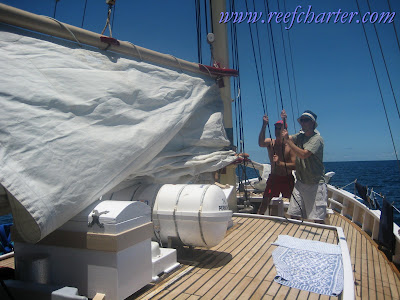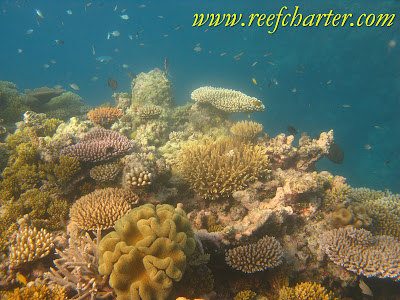Sailing the Santa Maria around the Great Barrier Reef is one of the privileges that we get to enjoy everyday.
Experiencing the romance and character of the historic wooden yachts is a rare experience and something our guests cherish for years, many becoming ‘addicted’ and returning many times for their fix. You can’t help as you sit with only a small group of people and share the water with a select few this is how nature was meant to be experienced.
Whether you want to experience snorkelling without the masses on the water or dive and explore the reef on your own terms and schedule, visiting the reef with small groups allows you to get a more personal and relaxed experience on the reef. Time spent with other passengers and our staff get you to enjoy and learn about the reef in a more intimate and one on one setting. It is an amazing difference as you dive, snorkel and relax on the outer Great Barrier Reef enjoying the coral and wildlife in a much more serene setting.
Tag: snorkelling
10 Tips for Great Underwater Photos
“You Taking a Photo of Me?”
At a request from Rob here is an article on how to take some great photos in the water. Thanks for the suggestion Rob and hope to see you back in Australia shortly. If you have a request for an article on one of our specialties please ping us on Twitter.
1 . As with anything in the water it is best to best to be calm and relaxed and move slowly. Taking photos while in the water either diving or snorkeling takes a little practice and is better if you work with the elements rather then against them.
2. Try to time the taking of the photos with the movement of the water, wind and other environmental variables. Again do not fight them but relax move in harmony with the elements.
3.Whether snorkeling or diving work on your stability in the water that means your buoyancy and how you are able to balance and relax in the water. It will take some practice to be able to become stationary, but well worth the effort.
4. Start taking pictures of fixed objects first such as reefs, underwater structures, corals, etc first. This will help your stability above and give you confidence to be able to frame your picture later. Keep your distance steady, slowly adjust the camera. Making adjustments quickly and constantly will make for erractive and out of focus pictures.
5. Hire a digital camera, this way you can take as many pictures as you want without running out of film. It is best to hire a small compact digital camera without strobes until you get your buoyancy correct. Heavier cameras make it difficult to hold a steady shot for the beginner.
6. Let your dive instructor or guide know that you want to practice taking photos; this will allow them to pick something that will photograph well and also plan the dive appropriately so you have all the time you need to get confident.
7. Ask questions of your tour staff, they will be more then happy to show pointers and evaluate how to improve your photos if you ask.
8. Avoid crowds, dodging other divers and snorkelers will frustrate you as well as take away your focus from your job at hand. Stay with a friend and pay attention to each other to make sure you are in contact, it is very easy to get separated while taking photos.
9. Have fun and try to photograph subject matter you are interested in, this will make the process a lot more enjoyable and you’ll be surprised how quickly you improve if there is a little passion behind your photos.
10. Once you are confident and taking some good photos of corals have a go at the fish or turtles. If the fish or moving animals move away from you do not chase them. No matter how good a swimmer you think you are they are better. Relax and move on to the next object, if you are calm and relaxed they may even circle back giving you another opportunity for that perfect photo.
As you can see to start taking good photos you have to be relaxed and most of all enjoy the experience. After a short time you’ll be taking some great photos that you’ll be proud to show your friends, colleagues and relatives for years to come. Here are some of the photos that our previous guests have taken. You too can be taking some great photos on the reef in a short time also. So if you are heading to Cairns or the Great Barrier Reef we’d love to show you some of the tricks of the trade.
Enjoying Your Reef Dive & Snorkel
Understanding the reef and the ecosystem that it is part of brings a much better fulfillment to each dive or snorkel that you partake in. Every reef is slightly different and the marine life and coral formations can vary a great deal with reefs just a few miles apart. Going with an operator that knows the reef and the ecosystem is a definite pre-requisite to getting the most out of every time you hit the water.
A basic understanding the life-cycle of a coral reef helps you understand what you are seeing take place in front of your eyes. Coral form in different ways in different parts of the world and each location may have it’s peculiarities due to tides, currents, temperatures and a myriad of other factors. So it is best to dive with a local expert and someone who cares about the reef that you are diving. There are plenty of predators and destructive forces that prey upon the corals that make up the beautiful underwater landscape. This is a natural part of the life-cycle of a reef and is why you will see parts that appear dead or like rubble. The healthier the reef, the higher the percentage of coverage of coral, however there always needs to be some areas that are not covered so new corals can take hold and grow as part of the reef. Much like a tree needs a break in the forest to get sunlight to grow, often a larger tree must die and fall for this to happen and the life-cycle to continue.
The fish, turtles, sharks, starfish, rays and other marine life that surround reefs are also part of the balanced ecosystem. Local knowledge and educated staff can tell you the role each of them play. Are they are predator? Do they eat algae? Do they eat the coral? Do they filter water? Each of them have their special place in the ecosystem. This balance needs to be maintained to keep the worlds’ reefs healthy and vibrant for the next generation. The healthier the reef the more resistant it is to any disease or adverse impact it may suffer. Feeding fish while it may make your dive or snorkel more exciting as after periods of time marine life will flock to the area, it upset the balance that the reef has taken generations to reach.
So on your next trip study a bit before you go and learn about the area and ecosystem you are about to visit. You may even learn something the local expert has yet to discover. Then choose the tour carefully to make sure you get the most you can out of your experience.



